Distilled water is completely pure water, containing just hydrogen and oxygen. You might want to make distilled water for drinking, fill aquariums and humidifiers, use to diffuse essential oils, and more.
In this guide, we’ll be sharing the step-by-step process to make distilled water.
📌 Key Takeaways
- Making distilled water at home is easy, but time-consuming.
- You can make distilled water at home by boiling and evaporating water with a single stove-top setup.
- Store distilled water in a sealed glass container away from direct sunlight.
- There are many ways to use distilled water, including for drinking, cooking, cleaning, and filling water-using appliances.
Table of Contents
🚰 Can You Make Distilled Water At Home?
It’s possible to make distilled water at home. No need to spend your money on bottled distilled water when you could make it yourself.
However, the process of making distilled water is incredibly time-consuming, and it’s not normally possible to make big batches at once.
Take a look at the steps below and decide whether the process is worth your time.
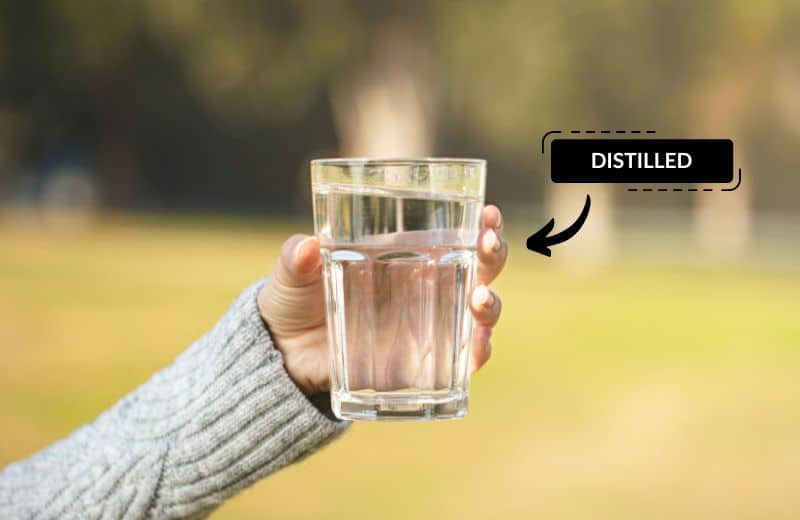
📖 How to Make Distilled Water in 5 Easy Steps
Here’s the easiest way to make distilled water with just a few tools at home.
You will need:
- A large stainless steel pot with a lid
- A small pot (about half the size of the large pot)
- Ice cubes
- Normal tap water
- A stovetop burner
📌 Note: you could also use this method with an outdoor setup. You just need a heat source (such as a campfire).
Step 1: Prepare Your Setup
Prepare for the distillation process by placing a large pot over your stovetop. Fill the pot with eight cups of tap water, then place a small pot inside the large pot. Make sure the small pot doesn’t touch the sides of the large pot – there needs to be enough space for airflow.
Don’t have a pot that’s small enough to fit inside the big pot? You can use a heat-resistant glass bowl on top of a baking rack. Just place the baking rack in the big pot, followed by the glass bowl, to prevent it from touching the pot and overheating.
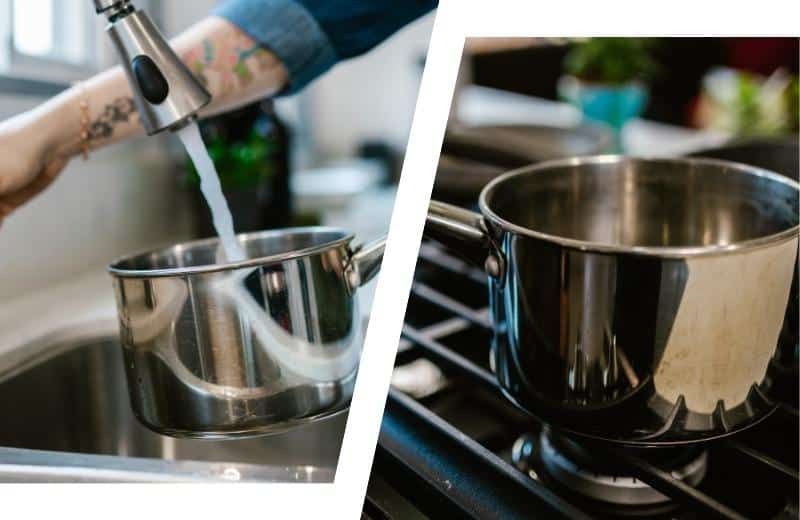
Step 2: Turn the Burner On
Next, put the burner on a medium- to medium-high heat. The water should steadily simmer but not boil at this temperature. Listen for the hissing sound of simmering water, and turn down the heat if you hear the bubbling of boiling water.
What’s the danger of a too-high temperature? It’ll cause the upside-down lid to heat up faster, which will slow down the process of distillation.
Step 3: Begin Distilling
Once you’ve turned the burner on, place a pot lid upside-down on top of the big pot. Why is the lid of the pot upside down? Because this is how water will drip down the inverted lid and into the small pot. Since lids are usually higher in the middle than around the edges, you couldn’t do that if the lid was the right way up.
Load the top of the lid with ice cubes from your freezer or ice maker. This will cool down the glass of the lid, and the difference in the temperature of the boiling water and the glass should speed up the evaporation process.
Step 4: Wait (And Replenish The Ice)
Making your own distilled water is a lengthy process, so there’s nothing to do now except wait.
Replenish the ice cubes whenever they turn to water. You’ll need to add fresh ice approximately once every 30-45 minutes. The lid will be hot, so wear oven gloves when dumping the melted ice water to avoid burning.
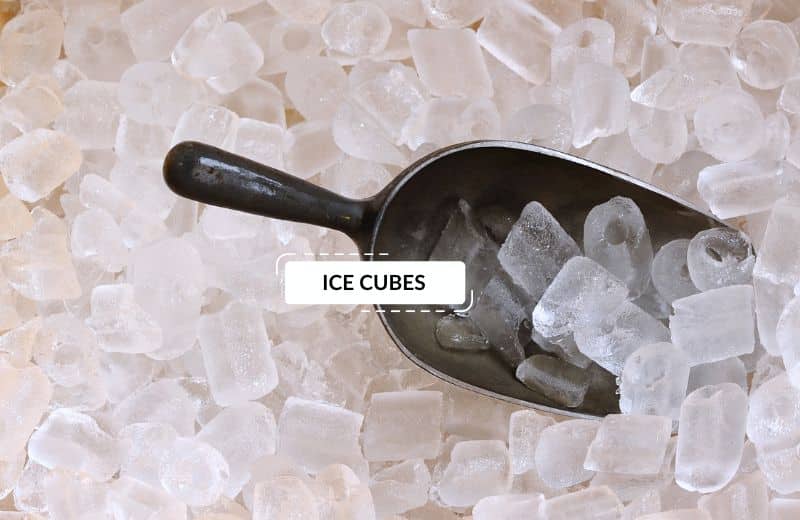
Step 5: Store the Distilled Water
It should take just over an hour to distill a full 8-cup batch of tap water. Check the progress from time to time and remove the pot from the burner once all the tap water in the big pot has evaporated. You don’t want to accidentally heat water in the small pot and cause that to start evaporating, reversing your progress.
We’ve shared how to safely store distilled water later in this guide.
📝 Other Methods of Distilling Water
The pot and bowl method is the best method of distilling water – but are there any other options to consider?
Yes. Here are a few other ways to drink “homemade” distilled water at home:
Collect Rainwater
Rainwater and snow are examples of naturally distilled water – water that has evaporated into the atmosphere and condensed into rain. You can collect rain or snow in a container with a fine mesh top.
Rainwater collection is completely free, so it’s a great option if you live in an area that gets a lot of rain. Just keep in mind that rain and snow aren’t quite as pure as DIY-distilled water because they collect pollutants and other contaminants in the atmosphere as they fall. You could run the water through a coffee filter for additional filtration, but this isn’t guaranteed to remove all impurities.
Use a Home Distillation Kit
A home distillation kit saves you the effort of distilling water yourself. A countertop distiller will boil water, then carry the evaporated water to the spout, where it condenses into a clean container.
You won’t need to do anything to encourage the process once you’ve added tap water to the boiling chamber and switched the distiller on.
The downside of home distillation kits is that they’re much costlier than any other method of distillation. The average home distiller costs $75-$350, depending on the quality and size of the distiller.
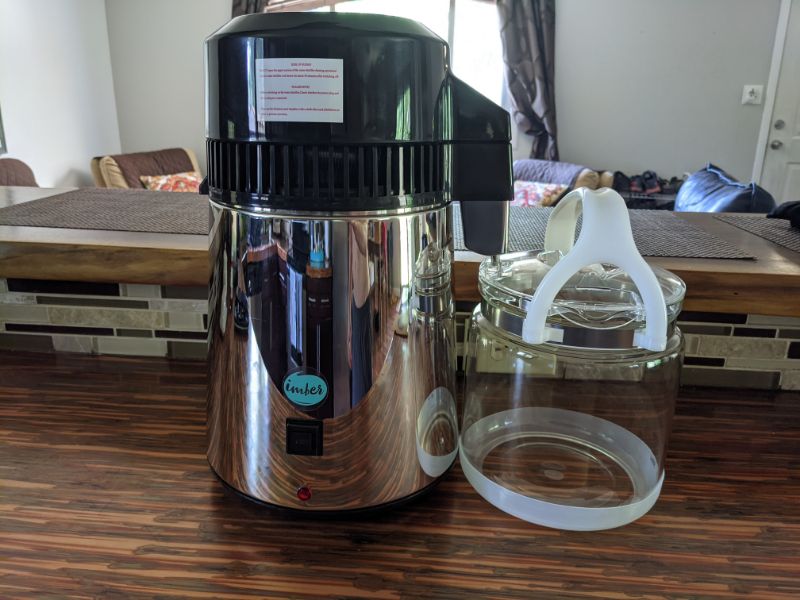
Distill Water From Plants or Moist Soil
If you’re out in the wilderness or you’re facing an emergency situation, you can make distilled drinking water from damp plants or soil (avoid poisonous plants, for obvious reasons). This process is incredibly time-consuming, but it’s good to use as a last resort.
Here’s an example of how you could distill water from plants or mud:
- Choose a sunny patch of soil and dig a hole in the ground.
- Place a can, such as a coffee can, in the hole, then stuff damp, green plants all around the outside of the can.
- Use plastic wrap to cover the hole. Make sure the wrap is properly sealed to prevent moisture from escaping.
- Place a pebble in the center of the plastic wrap. This will cause the center of the plastic wrap to dip.
- Over time, the sunlight should heat up the hole, causing the water to evaporate from the damp plants. The evaporated water will then hit the plastic wrap, condense, and drip from the middle of the plastic wrap into the coffee can.
- Keep the process going by adding more and more fresh plants until you have enough water for drinking.
📥 How to Store Distilled Water
Once you’ve made your own distilled water, you need to keep it protected from contamination to ensure it’s safe to drink.
Distilled water is completely pure, which means it’s more susceptible to picking up contaminants from its environment, like heavy metals and plastics. Don’t keep distilled water in a plastic or metallic container for this reason.
The best container for storing distilled water is an airtight glass container. Store the water in the fridge for up to two years.
If storing the distilled water outside of the fridge, keep it in a cool, dark location. Avoid areas of damp, humidity, and mold.
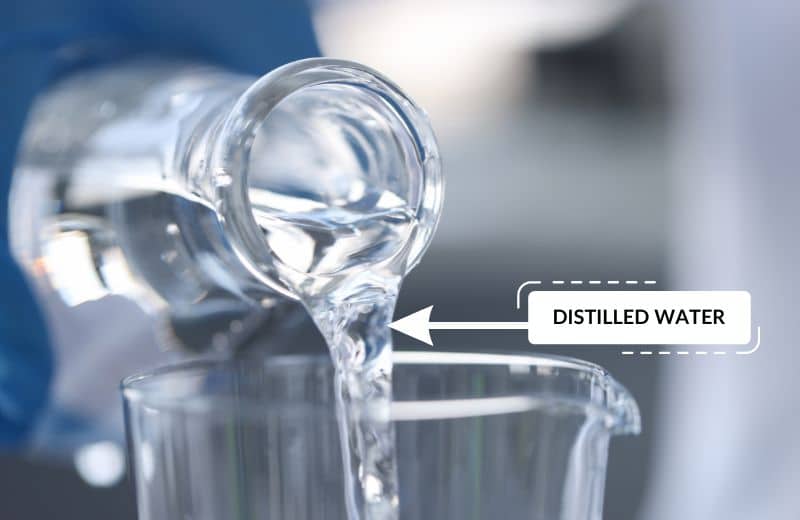
✅ Distilled Water Uses
There are a few ways to use distilled drinking water:
- Drink it – The most obvious use of distilled water is for drinking. Distilled water is safe, if not slightly bland-tasting. Some people prefer to distill water for drinking because they know it contains no potentially dangerous contaminants.
- Use it in appliances – Humidifiers, essential oil diffusers, irons, steamers, kettles, and coffee pots should all ideally be used with distilled water. This will prevent calcium and magnesium minerals (present in normal tap water) from causing scaling in the appliances and reducing their efficiency.
- Feed pets and water plants – If you’re concerned about the effects of potential contaminants on your pets or plants, you can use distilled water instead.
- Fill aquariums – Certain contaminants in tap water, like nitrate and chlorine, can be deadly to aquatic life. It’s strongly recommended to use a type of purified water, like distilled water, to fill home aquariums.
- Car cooling systems – If you need to top up your car’s cooling system, distilled water is safest.
❔ How to Make Distilled Water: FAQ
Does boiling water distill it?
No, boiling water is only part of the distillation process. If you only boil your water, you’ll remove the few contaminants that vaporize when they’re heated, such as chlorine. To properly distill water, you need to turn all the liquid water into water vapor, then allow it to condense into a clean container.
How is DIY distillation different from distillation in a distiller?
DIY distillation uses essentially the same process as a distiller does. In DIY distillation, the water vapor condenses when it hits the upside-down lid and drips into a smaller pot. In a distiller, the water vapor is carried down a cooling corridor and condenses into a separate container.
Is distilled water good for you?
Drinking distilled water is not unhealthy, but it’s not particularly healthy, either. Distilled, purified water is devoid of potentially beneficial minerals, like calcium, magnesium, potassium, and sodium. You can get these minerals in abundance from your diet, but by only drinking distilled water, your daily mineral intake may be lower than usual.
What’s better, distilled water or bottled water?
Distilled water is typically purer than bottled water, although this depends on the water source. Some bottled water brands use distilled water. Read the label carefully to make sure your bottled water is free from contaminants.
What’s the difference between filtered water and distilled water?
Filtered water is water that has some of its contaminants removed, but isn’t entirely pure. There are several types of filters that remove different contaminants. Distilled water can only be made by water distillation: the evaporating and condensation process. When you distill water, it is completely purified.

I have read that even with a home distiller the result may contain “stuff” that becomes a gas at or below the temperature of boiling water. Do I want to use reverse osmosis to filter the water prior to distillation? I am working with a major city’s tap water. I notice a really foul smell when I distill the city water. Anyone have any thoughts?
Reverse osmosis and distillation are two of the best methods to actually purify water. You wouldn’t need to use both, as that would be redundant. I prefer reverse osmosis, since they provide much quicker access to purified water and are able to target a broad range of contaminants.
What you mentioned about some gasses (also known as volatile organic compounds, or VOCs) not being reduced by distillation is true. These gasses are dissolved in water and are able to evaporate with the water when it boils. Most modern distillation units employ some sort of carbon filtration element to capture any of these VOCs that might be present post-distillation.
It’s odd that you are detecting a foul smell with the distilled water. This indicates something else, perhaps recontamination and bacterial growth. How often do you clean the vessel the distilled water drips into?